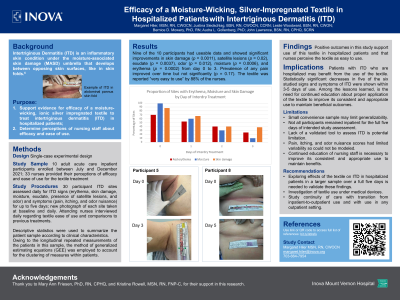Clinical Research
(CR-023) Efficacy of a Moisture-Wicking, Silver-Impregnated Textile in Hospitalized Patients with Intertriginous Dermatitis (ITD)
Friday, April 28, 2023
7:15 PM - 8:30 PM East Coast USA Time

Audra Gollenberg, PhD – Shenandoah University; John Lawrence, BSN RN CPHQ SCRN; Bernice Mowery, PhD, RN – Inova Health System; Justina Siedschlag, BSN RN CWOCN CCRN – Wound Ostomy Coordinator, Inova Mount Vernon Hospital; Leslie Woodward, BSN RN CWON – Wound Ostomy Coordinator, Inova Mount Vernon Hospital
Introduction: A single-case experimental design study in hospitalized adults with signs and symptoms of intertriginous dermatitis (ITD) during their admission to a 237-bed, mixed acute care/acute rehabilitation, Magnet-designated hospital.
There are millions of sufferers of ITD in acute with signs and symptoms including pain, burning, itching and various forms of skin damage. This nurse-led research team set out to further the evidence in support of a non-pharmaceutical method to manage the condition and improve patient outcomes. Perceptions of bedside clinicians were also assessed and contributed to the body of evidence.
Methods: A clinical nurse team collaborated to assess the efficacy of a moisture-wicking, ionic-silver-impregnated textile to treat ITD. The team developed an assessment tool to evaluate skin changes, created a data collection tool with established inter-rater reliability, and educated staff on ITD and textile usage. Participants were identified and consented to participate; baseline photographs and assessment documentation were completed; and the textile was placed. Each participant was evaluated daily for up to five days to evaluate ITD and photographs were taken of each affected area. Nurses caring for study participants were surveyed about their evaluation of the textile.
Results: Nine of the 10 participants had usable data and showed significant improvements in skin damage (p = 0.0011), satellite lesions (p = 0.02), exudate (p = 0.0037), odor (p = 0.012), moisture (p = 0.0006), and erythema (p = 0.0002) from day 0 to 3. Prevalence of any pain improved over time but not significantly (p = 0.17). The textile was reported as easy or very easy to use by 97% of the nurses (n = 33).
Discussion: Positive outcomes in this study support the efficacy of the textile in hospitalized patients. Nurses perceive the textile as easy to use. Among the lessons learned is the need for continued education to improve consistent and appropriate textile use to maintain beneficial outcomes.
There are millions of sufferers of ITD in acute with signs and symptoms including pain, burning, itching and various forms of skin damage. This nurse-led research team set out to further the evidence in support of a non-pharmaceutical method to manage the condition and improve patient outcomes. Perceptions of bedside clinicians were also assessed and contributed to the body of evidence.
Methods: A clinical nurse team collaborated to assess the efficacy of a moisture-wicking, ionic-silver-impregnated textile to treat ITD. The team developed an assessment tool to evaluate skin changes, created a data collection tool with established inter-rater reliability, and educated staff on ITD and textile usage. Participants were identified and consented to participate; baseline photographs and assessment documentation were completed; and the textile was placed. Each participant was evaluated daily for up to five days to evaluate ITD and photographs were taken of each affected area. Nurses caring for study participants were surveyed about their evaluation of the textile.
Results: Nine of the 10 participants had usable data and showed significant improvements in skin damage (p = 0.0011), satellite lesions (p = 0.02), exudate (p = 0.0037), odor (p = 0.012), moisture (p = 0.0006), and erythema (p = 0.0002) from day 0 to 3. Prevalence of any pain improved over time but not significantly (p = 0.17). The textile was reported as easy or very easy to use by 97% of the nurses (n = 33).
Discussion: Positive outcomes in this study support the efficacy of the textile in hospitalized patients. Nurses perceive the textile as easy to use. Among the lessons learned is the need for continued education to improve consistent and appropriate textile use to maintain beneficial outcomes.

.png)